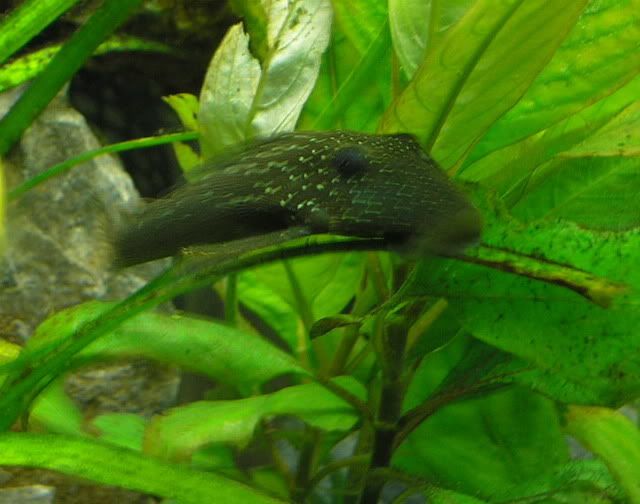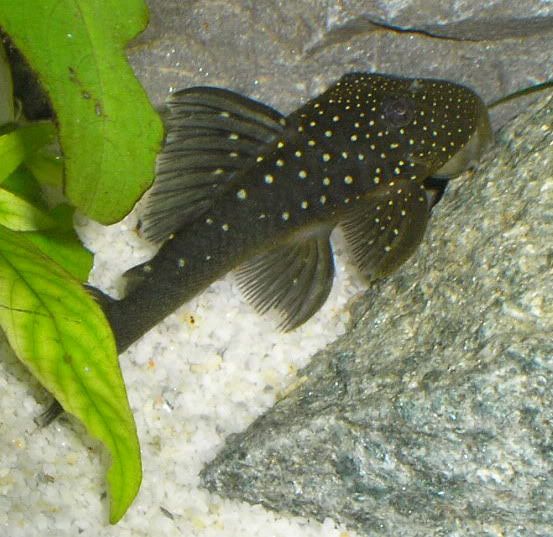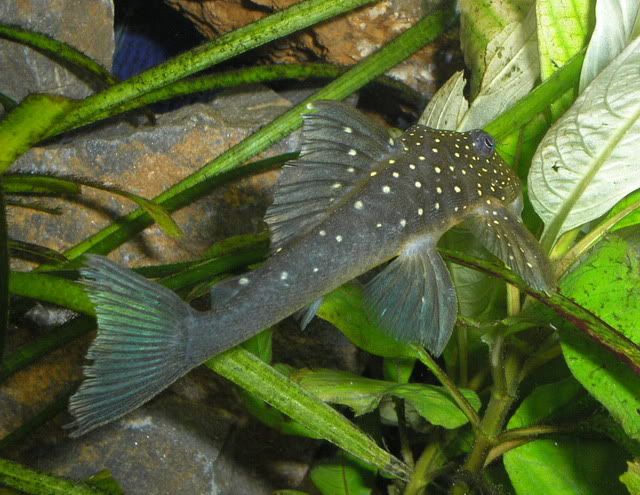Page 1 of 1
L-200? or L-128?
Posted: 06 Apr 2006, 16:11
by JoseAngelBarro
Posted: 06 Apr 2006, 20:06
by funkyj1313
L128
Posted: 07 Apr 2006, 00:44
by O_o
agree, blue phantom
Re: L-200? or L-128?
Posted: 07 Apr 2006, 07:34
by puertoayacucho
Hi Jose, could you tell us if you purchased it or caught it yourself? I see you're in Valencia, Venezuela? I'm in SLC, Utah but I've caught this variety just outside Puerto Ayacucho (Pozo Azul locality).
I can tell you as far as the differences between L-200 and L-128 that basically it's the color. Elsewhere in this website there is a nice article at
http://www.planetcatfish.com/cotm/2003_09.PHP
I have collected this fish from La Esmeralda, Alto Orinoco (in Amazonas) all the way to Caicara, Bolivar and coincide with the indicated article that is basically a same species with localized variations, BUT THEN, I'm not a specialist in loricarids, nor catfish in general, but I am really fond of these fish as a compliment to my Orinoco cichlids.
Ed
Posted: 08 Apr 2006, 00:31
by Shane
I am starting to wonder about the L 128/L 200 designation. I have seen several photos lately sent to me by aquarists whose fish was clearly L 128 (black) at one point and clearly L 200 (green) a year later. I am beginning to wonder if one coloration or the other is not simply a byproduct of diet in the wild.
-Shane
Posted: 08 Apr 2006, 14:06
by puertoayacucho
Shane wrote:I am starting to wonder about the L 128/L 200 designation. I have seen several photos lately sent to me by aquarists whose fish was clearly L 128 (black) at one point and clearly L 200 (green) a year later. I am beginning to wonder if one coloration or the other is not simply a byproduct of diet in the wild.
-Shane
Hi there Shane, this is Ed Ruiz, I have written to you in past years concerning
P. suttonorum, sorry for not keeping in contact but living now in SLC and the way things are going down in Venezuela, my friend Wil (and his quest for the blue eyed grail) are "parados". FARC roaming in all the way to Machiques and Maracaibo outskirts.
As to the L-200/L-128 issue, I too would think diet may have something to do with the color variations, though I have observed a relation between water turbidity, darker fish in water with higher turbidity and lighter, greener fish in clearer water. Not so much as saying that they will be greener down south and necesarilly darker northwards. Though what I've caught near La Esmeralda are definitely a brighter green, I have caught some drabbier green/mustards in Pozo Azul (in a clearwater feeder stream) and grey/blues in Pozo Cristal (in considerably slower water by the way) - may be 5 or 6 miles away (sure you remember these two localities, 20 minutes North of PAY on the way to Caicara.
In anyway, I am looking at these as a same species.
Ed
Posted: 08 Apr 2006, 14:14
by Shane
Ed,
Great to hear from you again! Turbidity and other water-related factors could certainly be factors with the various differences in coloration from green to black being localized adaptations.
-Shane
Posted: 08 Apr 2006, 16:21
by JoseAngelBarro
Hi all.
puerto ayacucho (nice name nice town ;) )
This fish is purchase by a friend.
Shane then is probbable that coloration change in a year; This change It´s for to be juvenil? or stress? or what?
Sorry for my english
Posted: 08 Apr 2006, 18:16
by Shane
Jose Angel,
Creo que las diferencias puedan ser el resultado de su dieta o las condiciones del aqua (claro, negro, blanco, etc), o mas possible todavia una combinacion de los dos factores.
-Shane
Posted: 08 Apr 2006, 18:33
by JoseAngelBarro
Gracias Shane por la amabilidad de hacerlo en castellano

Entonces este es un L-128? O es muy joven para saberlo?
Then this is a L-128? Or is juvenil for to know?
Posted: 08 Apr 2006, 20:39
by Jorge
Yes. to me is a L128. It has separated dorsal and adipose fins (that means
Hemiancistrus) and has spots beyond the dorsal. Coloration is not definitive to tell apart L128 from L200
If you want, can read in spanish about that fish here:
Hemiancistrus sp. (L128)
Saludos
Posted: 08 Apr 2006, 22:17
by JoseAngelBarro
Thanks Jorge;
Gracias Jorge ;)
Posted: 11 Apr 2006, 06:29
by puertoayacucho
Jose Angel, coincido con Shane, ambos factores, dieta y biotipo, pueden incidir sobre la coloración, de modo que sólo en base a este último, es muy difÃcil determinar con precisión la especie de que se trata. La relación que yo he observado, es que en aguas más cristalinas, o aguas negras/claras, como las que solemos ver en el Alto Orinoco y bajando casi hasta la boca del Ventuari, y de allà hasta la curva de Atabapo, he visto ejemplares de colores verde intenso, verde/mostaza y verde aceituna. En la medida que el agua va recogiendo sedimento, de Atabapo hasta Puerto Ayacucho, es más común ver ejemplares de tonos amarronados y entre Ayacucho y Caicara (carga de sedimento mayor), los he visto ya grises, azulados y negros. Sin embargo, en la vecindad de Pozo Azul y Pozo Cristal, 20 minutos al norte de Puerto Ayacucho, via a Caicara, en una misma localidad, a muy poca distancia entre si, he colectado ambas variedades. En este sitio, dada las variables en los dos biotipos y lo observado, hice estas conjeturas en torno al color.
Saludos,
Ed
Posted: 12 Apr 2006, 00:55
by JoseAngelBarro
Vaya que conoces la zona

Y veo que hablas muy bien el castellano tambien; muchas gracias por hacerlo

Ya he comprendido todo y voy a tener que darme mi viajecito a todos estos lugares que me has citado para echarle un ojo por mi mismo

Gracias;
Posted: 12 Apr 2006, 04:04
by Shane
Jose Angel,
Ed es pana y mas criollo que la arepa.
-Shane
Posted: 12 Apr 2006, 13:42
by JoseAngelBarro
Ya decia yo que ese lenguaje y esa manera de describir tenia que ser de un compatriota venezolanito

Aunque tu Shane tambien eres ya medio venezolano ;)
Hi





